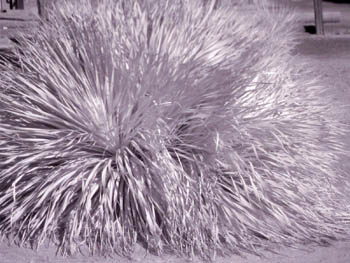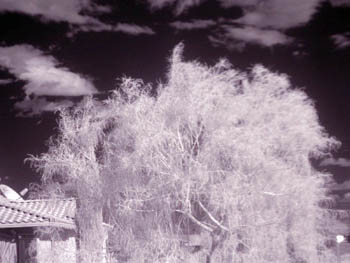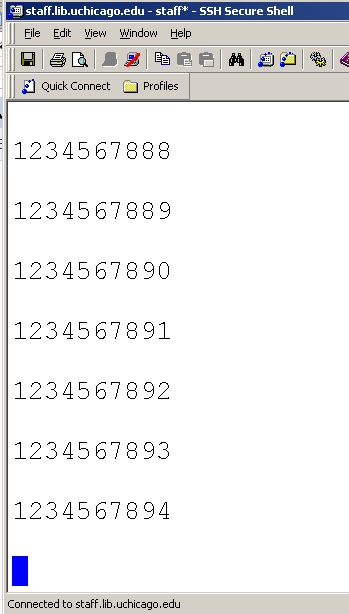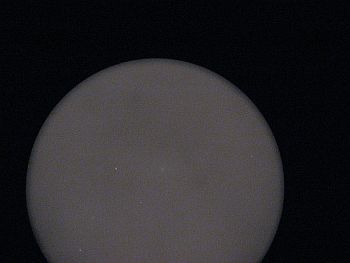
Tuesday, February 24, 2009
Comet Lulin from Chicago
The RAS observed Comet Lulin in Chicago yesterday. Unforunately it wasn't 100% clear, with some sort of high cirrus haze up, and with all the light pollution, only two of us saw the blob that was the comet. For proof of where it was, I took a quick snapshot through the eyepiece to confirm the location for others looking.


Monday, February 23, 2009
astronomical acronym
A cute acronym. It would only be better if the project was one of those requiring exquisite precision in their measurements and error-handling.
Title: The HYPERMUCHFUSS Campaign -- an undiscovered high velocity population
Authors: Alfred Tillich, Stephan Geier, Uli Heber, Heiko Hirsch, Pierre Maxted,
Boris Gaensicke, Tom Marsh, Ralf Napiwotzki, Roy Østensen and Chris
Copperwheat
Categories: astro-ph
Comments: 8 pages, 6 figures, to appear in the Journal of Physics Conference
Proceedings (JPCS) for the 16th European White Dwarf Workshop, Barcelona,
Spain, June 30 - July 11, 2008
We present an overview and a status report of HYPERMUCHFUSS (HYPER velocity
or Massive Unseen Companions of Hot Faint Underluminious Stars Survey) aiming
at the detection of a population of high velocity subluminous B stars and white
dwarfs. The first class of targets consists of hot subdwarf binaries with
massive compact companions, which are expected to show huge radial velocity
variations. The second class is formed by the recently discovered
hyper-velocity stars, which are moving so fast that the dynamical ejection by a
supermassive black hole seems to be the only explanation for their origin.
Until now only one old hyper-velocity star has been found, but we expect a
larger population. We applied an efficient selection technique for hot
subdwarfs and white dwarfs with high galactic restframe velocities from the
SDSS spectral data base, which serve as first epoch observations for our
campaign with the ESO VLT and NTT in Chile, the 3.5 m telescope at DSAZ
observatory (Calar Alto) in Spain and the WHT on La Palma. The survey is
nearing completion and provides us with promising candidates which will be
followed up to measure their RV-curves to uncover massive companions or prove
their nature as HVS.
\\ ( http://arxiv.org/abs/0901.1030 , 1617kb)
Friday, February 20, 2009
IR focus test: Regenstein Bartlett Quad
Monday, February 16, 2009
Friday, February 13, 2009
Giant's Causeway on Mars
Much like the original Giant's Causeway, the universality of basalt lava exists elsewhere in the inner solar system--including Mars. Here is a very reasonable interpretation of a basalt flow on Mars.
 .
.
I still need to scan my Iceland crazy basalt cooling images.
 .
. I still need to scan my Iceland crazy basalt cooling images.
Wednesday, February 11, 2009
Satellite collision: story to watch for future complications
Two satellites collided in orbit two days ago, creating a spray of debris that will have to be closely watched to avoid further collisions. One satellite was an Iridium, one of the 88 or so in orbit (I see it was #33), and the other was a non-functioning Russian Cosmos satellite. I hope the Cosmos had either ejected the nuclear reactor that some of them use or was non-nuclear. I see another nuclear Cosmos had a problem recently. What's interesting about this collision was the height: at 490 miles, the debris is fairly high enough to have some significant lifetime. As debris densities increase, chances of collision greatly increase, greatly increasing debris densities, increasing collisions, which... you get the idea. These sort of things are really bad for our near Earth environment.
Here's a graph of the two orbits. It was a bad high energy collision.
UPDATE: Animation of the two satellites colliding (in a virtual sense).
Here's a graph of the two orbits. It was a bad high energy collision.
UPDATE: Animation of the two satellites colliding (in a virtual sense).
Tuesday, February 10, 2009
A gorgeous galactic grauve
Actually not a grauve, but an image:

Make sure you look at the largest image you can comfortably download, and enjoy the relation of the size of the background galaxies to the foreground one. A true sense of the Universe.
From Bad Astronomy.

Make sure you look at the largest image you can comfortably download, and enjoy the relation of the size of the background galaxies to the foreground one. A true sense of the Universe.
From Bad Astronomy.
Saturday, February 07, 2009
Another moon mosaic
Friday, February 06, 2009
Science Press Releases
Sometimes I feel for the fellows working the Science press racket. They have to distill the complicated nature of research science into a tidbit that the mainstream media will be able to digest and regurgitate into yet another tidbit.
But sometimes I am annoyed. I feel the words "strange", "mysterious", "hidden", and "stunning" have no place in a science press release. The best ones use direct references to the science, do not declare commonly known principles or phenomena as "mysterious", and work their best to educate the reader about the science being done. They do not use poor analogies. I know a few of the writers, and sometimes problems like these develop not from them but from their employers.
This is not that. And the Register called him out on it. It is in no way the worst example of the science press release. I would be more sympathetic if the writer would take the Register's criticism to heart about that analogy.
But sometimes I am annoyed. I feel the words "strange", "mysterious", "hidden", and "stunning" have no place in a science press release. The best ones use direct references to the science, do not declare commonly known principles or phenomena as "mysterious", and work their best to educate the reader about the science being done. They do not use poor analogies. I know a few of the writers, and sometimes problems like these develop not from them but from their employers.
This is not that. And the Register called him out on it. It is in no way the worst example of the science press release. I would be more sympathetic if the writer would take the Register's criticism to heart about that analogy.
Thursday, February 05, 2009
Moon mosaic
A moon mosaic from last night. I didn't take the images or process them; Will did all that. The only thing I've done is run it through Autolevel in Photoshop. For processing, we took about thirty images each of each section of the Moon with the SXV-H9 camera at 1/1000s, and then ran each set through Registax to get the sharpest ones, then used Autostitch to put the sets together.
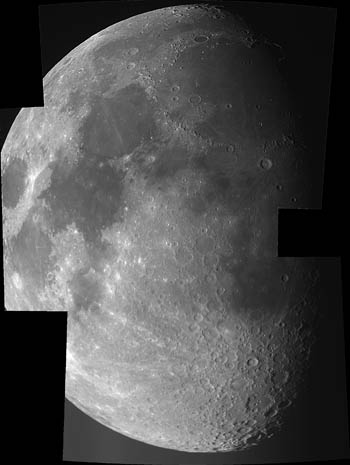
Click to enlarge.

Click to enlarge.
Sunday, February 01, 2009
The radio electromagnetic spectrum
This is a great chart of the entire electromagnetic spectrum. If you interested in the more organized allocations of the radio region, see this very detailed PDF chart.
Subscribe to:
Comments (Atom)

